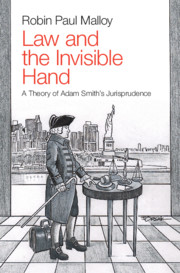Book contents
- Law and the Invisible Hand
- Law and the Invisible Hand
- Copyright page
- Dedication
- Contents
- About the Cover
- Figures
- About the Author
- Preface
- Acknowledgments
- Guide to Citations by Adam Smith
- 1 Introduction
- 2 Setting the Stage
- 3 Social Organization in the Informal Realm
- 4 Social Organization in the Formal Realm
- 5 Integrating the Informal and Formal in Smith’s Theory
- 6 The Spectator View
- 7 Judgment and Justice
- 8 The Sentiment of Common Interest
- 9 The Impartial Spectator, Homo economicus, and Homo identicus
- 10 Understanding the Four Stages of Progress
- 11 Adam Smith in American Law
- 12 Parting Thoughts
- Bibliography
- Index
3 - Social Organization in the Informal Realm
Published online by Cambridge University Press: 27 September 2021
- Law and the Invisible Hand
- Law and the Invisible Hand
- Copyright page
- Dedication
- Contents
- About the Cover
- Figures
- About the Author
- Preface
- Acknowledgments
- Guide to Citations by Adam Smith
- 1 Introduction
- 2 Setting the Stage
- 3 Social Organization in the Informal Realm
- 4 Social Organization in the Formal Realm
- 5 Integrating the Informal and Formal in Smith’s Theory
- 6 The Spectator View
- 7 Judgment and Justice
- 8 The Sentiment of Common Interest
- 9 The Impartial Spectator, Homo economicus, and Homo identicus
- 10 Understanding the Four Stages of Progress
- 11 Adam Smith in American Law
- 12 Parting Thoughts
- Bibliography
- Index
Summary
Adam Smith’s project of developing a theory of social organization and progress involved a need to understand the world around him. That is, he had to interpret his experiences and his observations of human interaction and organization. Part of his inquiry included the examination of history. He examined peoples and civilizations of the past to determine the fit between the historical record and his developing theory. He used his knowledge of history to populate his writings with numerous examples, and he used these examples in providing commentary on the lessons to be learned from them. Based on his understanding of history, Smith speculated about the underlying ‘mechanism’ propelling human cooperation and progress through time.
- Type
- Chapter
- Information
- Law and the Invisible HandA Theory of Adam Smith's Jurisprudence, pp. 21 - 39Publisher: Cambridge University PressPrint publication year: 2021

